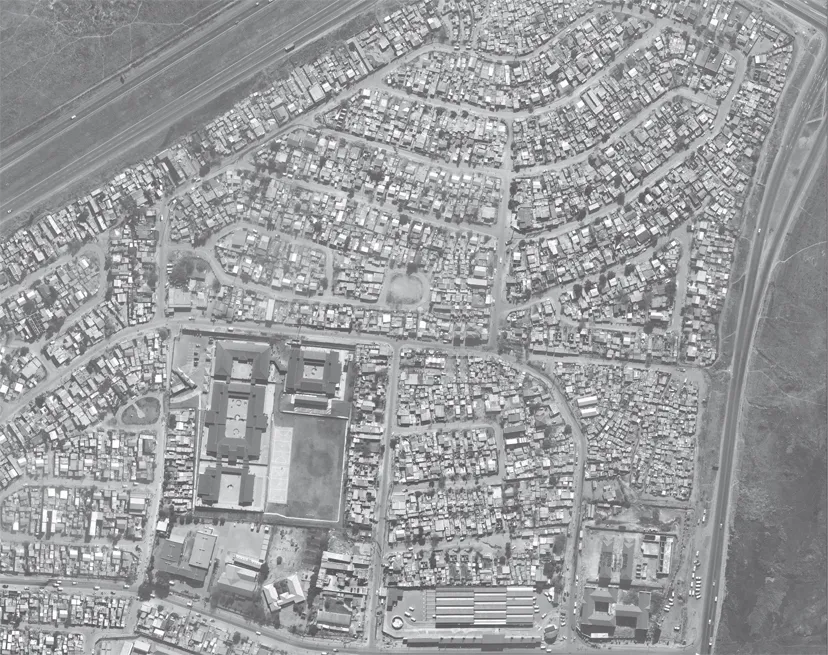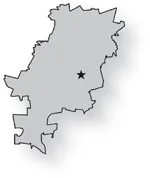![]()
SECTION B
AREA-BASED TRANSFORMATIONS
![]()
12Between fixity and flux: Grappling with transience and permanence in the inner city
YASMEEN DINATH
Restless city
How to upgrade and regenerate an inner-city environment where nothing is permanent but not everything is transient either? This seems to be the dilemma facing the City of Johannesburg Metropolitan Municipality. Does it rebuild an inner city that caters for a transient population and transient activities or does it rebuild it based on an assumption that greater stability is needed and that permanence is a legitimate aspiration? It seems that these choices lie at opposing ends of a continuum that the municipality has battled to position itself on when planning its interventions in the ever-changing spaces of the inner city.
Since pre-colonial times what is now the centre of Johannesburg has been the site of entering and leaving, staying put and moving on – a constant shift between transience and permanence. From the comings and goings of successive tribes of BaTswana, BaSotho and Matabele (Brodie 2008), to the arrival of Dutch settlers, to the appearance of prospectors, tradesmen and mine labourers – it has been a place of entry and exit, place-making and displacement, settling and struggling, a place where very little stays constant but some come to stay. Throughout these comings and goings, the spaces of the central city have played a number of different roles, some of which have been permanent while others have been transient and fleeting responses to the temporal and socio-political context of the day.
The bricks and mortar (or corrugated iron and timber) of the area we know as the inner city were put in place over the past 124 years. Each layer of the city’s physical fabric successively represents a spatial form that tried to suit the function of the day, but the physical make up of the buildings signify only a small part of their story. The inner city has played multiple roles through time and is still required to fulfil many competing, simultaneous agendas. This dynamism has been matched by an inconsistent, fluctuating and at times incoherent governance response. Rapid spatial change as a result of social, economic and political forces has exacted a considerable toll on the state. The question of how to design, plan, manage, in some cases ‘control’ and maintain this space in flux has plagued city administrators since 1886.
While much has been written about the pitfalls of the local authority’s neo-liberal approaches to urban regeneration in the inner city (Murray 2008, 2011), and yet more has been written about the experience of migrants in the city (Kihato 2007, 2010; Landau 2006, 2009; Simone 2004), the various ways in which the local authority has grappled with governance of the inner city in the post-apartheid era has not yet been fully examined. There has been less scholarship on the ways in which the local authority has grappled with understanding the inner city as a place of simultaneous transience and permanence and what it has chosen to do about this. One possible exception is the work of Lindsay Bremner (2000, 2002, 2004), which goes a considerable way in addressing some of these and other broader issues relating to regeneration in the inner city. Another exception is Chapter 13 of this volume in which Claire Bénit-Gbaffou examines the governance of fluidity and flux in the context of the great diversity of the inner city’s north-eastern suburbs.
I begin the chapter by exploring how transience and permanence have always formed part of the inner city’s DNA, from its days as a mining camp to the uncertain days of the demise of apartheid, and I argue that transience and flux have always presented a challenge to city government. I draw on my experience as a municipal official tasked with guiding spatial planning policy for regeneration efforts in the inner city, and after a brief description of the inner city as it is today, I discuss the two impulses that have driven the municipality’s approach to inner-city regeneration in the past decade of spatial change. The first impulse is the municipality’s impulse to create fixity, discipline and aspirational iconic physical spaces. The second is to implement reactive and quick-fix solutions to some of the more enduring phenomena that have arisen in the inner city. I also discuss how systemic barriers within the city administration make more relevant and effective management difficult in the context of the fixity and flux of the inner city. Rather than concluding with a set of normative suggestions, I re-emphasise that systemic hindrances within the city arrest its ability to manage the inner city amidst and despite the area’s fixity and flux.
Emerging through permanence and transience: a brief history
From the early days of colonialism in Africa, Johannesburg’s inner city represented the gateway to southern Africa. The discovery of gold and the ensuing gold rush led to a rapid influx of people to the area and this made proper state-led planning a challenge. Johannesburg was never expected to be a permanent settlement. It was thought that once the gold deposits had been depleted, the mining camp would pack up and move off in search of other fortunes (Brodie 2008).
From transience to permanence: a city struggling into being
This assumption of Johannesburg’s limited life expectancy, of it being a transient place where people might sojourn temporarily, had an impact on its spatial layout and form. A crude and rudimentary street layout developed by a land surveyor formed the basis of the inner city we know today (Beavon 2004; Brodie 2008), and this short-term, crisis-driven approach to planning and urban development has been difficult to shake off, particularly in the inner city.
The role and function of the early mining camp was unequivocally to serve the interests of extracting gold deposits as quickly and profitably as possible. Once the extent of the Reef was determined, and the city’s permanence was accepted, it began to be imagined as a longer-term destination where wealth could be made and markets accessed. Bricks and mortar were then laid down in ways that supported the city’s role as a centre for colonial wealth and power in sub-Saharan Africa.
While the first survey plans and stand demarcations for the inner city date back to October 1886, formal regulatory state intervention in the spatial layout and land use came about in 1931 when the first town planning scheme was prepared (Zack and Silverman 2009). Prior to this, when boer farmers arrived after escaping the Cape Colony, they simply grabbed space and crudely demarcated it using a one-hour horse ride as a way of determining the boundaries of a farm, irrespective of any claims to land by the local native inhabitants (Brodie 2008).
This rush on space has endured to the present day in the inner city. Whether the stakes have been a high-yielding property investment, a site for gold extraction or a bolt hole on a discarded, unused piece of land to secure the most marginal of footholds in the city, the demand for space within these few square kilometres has presented a constant challenge to the state’s impulse to plan, control and regulate. Some of the claims on space in the inner city are transient and others are more permanent and therein lies the rub.
When the British gained control of Johannesburg, they wanted the inner city to represent the success of the British colonial forces in Africa. Ornate iconic buildings were erected in the colonial style and other artefacts of British rule punctuated the urban space (Brodie 2008). With bold new buildings, plush neighbourhoods for mine managers and functional suburban housing developments for workers coexisting with tented camps, labour hostels and locations demarcated for ‘non-white’ race groups, the tenuous relationship between transience and permanence still characterised settlement and development in Johannesburg. The local authority tried to formalise and regulate activity but with mixed success. From the wanton women of the red-light district Frenchfontein, to the bootleggers who made many a man merry with illegal liquor (Brodie 2008), a spirit of insurgent urbanism undermined the authorities’ attempts to make good places in the expectation of making well-behaved and compliant citizens (Holston 1998).
During the 1930s when South Africa abandoned the gold standard, foreign investment poured into the city and iconic skyscrapers became de rigueur in the city centre, with corporations vying to outdo each other for the most impressive symbol of power and wealth in the city (Zack and Silverman 2009). The pace of formal development in the inner city increased rapidly and the scale of buildings changed dramatically. By the late 1930s, the inner city operated as the smart wealthy CBD of Greater Johannesburg. Its spaces were delineated to serve business interests, maximise productivity and display wealth and power.
Mining and business activity had come a long way since the days in which the first prospectors set up camp in what is known today as Ferreirastown, and mine labourers had been effectively squeezed out of the CBD. As early as 1904, the municipality cited the outbreak of bubonic plague among Africans as the reason for banishing black people from the central city. Thus the geographic alienation of African, coloured and Indian people from the city centre began well before the apartheid regime was formally implemented. The Native (Urban Areas) Act of 1923 and the Slums Act of 1934 were but two instruments that were used to prevent people of colour from living or trading in the inner city (Beavon 2004; Brodie 2008; Zack and Silverman 2009).
Under apartheid, with its formal spatial segregation through the demarcation of group areas, the inner city symbolised the entrenchment of white control over the economy and its resources. The local authority took increasingly harsh measures to quell any practices it deemed insurgent urbanism. At the same time it attempted to create landmark iconic spaces and buildings that projected white success and supremacy. However, while the local authority seemed to have the inner city and its users beautifully under control, and a veneer of functionality and stability veiled the inner city, this hid a darker underworld. For the black majority, the inner city could be a place of transience only. They were allowed to shop in it (albeit in black shops) and some were permitted to enter the city daily to sell their labour, but their attachment to and presence in the space was otherwise not tolerated.
Nevertheless, the South African economy’s favourable growth rate during the 1960s meant that 50 tower blocks were built in the inner city, increasing office space by more than 30 per cent. Yet, almost simultaneously, a massive decline began to set in. Restrictive parking regulations and the construction of the freeway system in the early 1970s sparked the beginning of capital flight to more attractive decentralised nodes such as Rosebank and Sandton (Zack and Silverman 2009). The ostensibly well-managed, well-functioning inner city began a downward spiral that lasted almost 30 years (Zack and Silverman 2009).
A new kind of permanence as the city slips
As apartheid failed, its demise was most stark in the so-called ‘greying’ of the city, in areas where the authorities could no longer prevent the entry of black people. This was keenly manifested in the inner city. Its spaces were reclaimed, appropriated, and secretly infiltrated by the various groups of South Africans who had been excluded from its stree...


